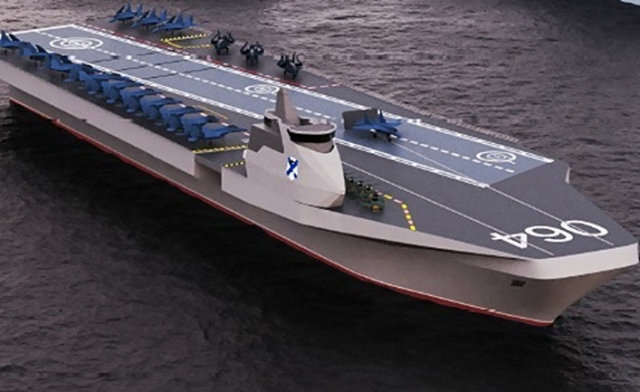In the United States, jealously watching the development of the Russian military-industrial complex, and therefore the message that the aircraft carrier "Admiral Kuznetsov" is being prepared to replace, aroused interest. But in the article, skepticism is mixed with interest: will Russia be able to implement interesting ideas? Will the Russian Federation repeat the success of its icebreaking shipbuilding?
Maybe someday the Russian Navy will seriously think about building a replacement for its only aircraft carrier-the outdated and very unreliable Admiral Kuznetsov. But not today. The next concept of a new-generation aircraft carrier created by the Nevsky Design Bureau in St. Petersburg is not very serious, experts say.
But it is certainly interesting. If all over the world the superstructure on the upper deck of aircraft carriers (or two superstructures) stands in the middle of the ship, then in the new draft design of the Nevsky PKB, the superstructure of the 250-meter aircraft carrier is located closer to the bow.
The graphic image of the aircraft carrier with a displacement of 45,000 tons prepared by the bureau is clearly not a reflection of a serious design idea. In the picture, the aircraft carrier does not even have a pipe for a supposedly non-nuclear power plant. But the placement of the pipes determines the scheme of its flight deck.
But the lack of a detailed project doesn't matter. The Kremlin does not allocate serious funds for the design and construction of a new aircraft carrier. And it is not clear whether his plans will change in this regard, and if they will change, when. Nevskoe design Bureau just dreaming out loud.
"The Russian defense industry has long been known for innovative thinking and design work ," said naval analyst Eric Wertheim, who is the author of the handbook "Combat Fleets of the World." "But it is equally famous for the excessive hype around new projects and systems that are unlikely to ever be implemented and go into service."
As an example, we can cite other concepts of new aircraft carriers, of which there are a great many. Russian industry has proposed several projects in recent years. The Neva bureau put forward the idea of creating a huge aircraft carrier with a displacement of 90,000 tons, giving it the name "Manatee". This ship will be able to take on board 60 aircraft, which is about twice as much as the Kuznetsov ,which has a displacement of 60,000 tons.
But the government has yet to approve a multi-year and expensive program to design and build a new aircraft carrier. Instead, it is spending hundreds of millions of dollars to repair, upgrade and extend the life of the vintage "Kuznetsov" built in the 1980s, although this ship has recently distinguished itself with several serious accidents.
"Admiral Kuznetsov", which is 300 meters long, was enlisted in the fleet in 1990. In the period from 1991 to 2016, he made only seven outings on combat duty. When the ship carried out combat missions off the coast of Syria in 2016, its air wing lost two aircraft in three weeks due to accidents.
In October 2018, Kuznetsov was seriously damaged while at the 82nd ship Repair Plant in Roslyakovo near Murmansk, when the PD-50 floating dock sank, which the aircraft carrier had entered for repairs.
And in December 2019, a fire occurred on board the Kuznetsov during repair work. Two workers were killed. The flames damaged the ship's already dilapidated electrical system.
After the fire, the command of the Navy thought about writing off this old and battered vessel. The Russian navy is building universal landing ships that can partially replace an outdated aircraft carrier. However, they will not be able to accommodate manned fighters.
But Moscow decided to repair the aircraft carrier, replacing the ancient boilers. The currently installed boiler installations emit thick black smoke during the voyage. According to the plan, the Kuznetsov should return to the sea for testing in 2022.
The reluctance to take risks and build new large ships has become something of a pattern in the Kremlin. During the Cold War, the Russian Navy had light aircraft carriers, huge cruisers with a nuclear power plant, and other large warships.
But the Russian shipbuilding industry has never fully recovered from the post-Soviet collapse. Some of the larger old Kuznetsov-class ships remained in service, but when building new ships, attention is almost entirely focused on small and simpler surface ships such as frigates and corvettes, as well as on submarines.
"The main problem is the engines," said Pavel Luzin, a military expert at Perm University. "The Russian industry is still not able to create sufficiently powerful and efficient propulsion systems for ships of these types." Western sanctions exclude the import of suitable power plants.
Apparently, the Russian industry will not be able to build a new aircraft carrier. But there is no limit to the imagination of Russian artists. "I believe that this concept design is likely to remain what it is - just a concept," Wertheim said. "At least in the short term, until most of the serious problems facing their military and civilian shipbuilding are resolved."
If there is a positive side to the whole story of the fictional aircraft carrier, it is that the picture gives Russian designers food for thought. The Nevsky Design Bureau intends to place a new mixed air wing consisting of 24 fighters, six helicopters and 20 drones on the new aircraft carrier.
The Russian Navy does not even have drones suitable for launching from aircraft carriers. All of this is in the future, just like the ship itself. And they can give a signal about the direction in which the Russian fleet will develop. Over time. Late.
"This is a concept," said Samuel Bendett, a researcher at the Center for Naval Analysis in Virginia. "But something else is more important: how they imagine the future war."
David Axe)

